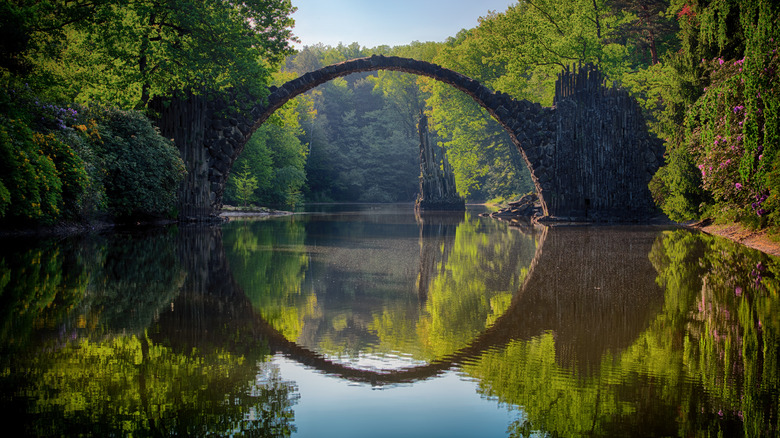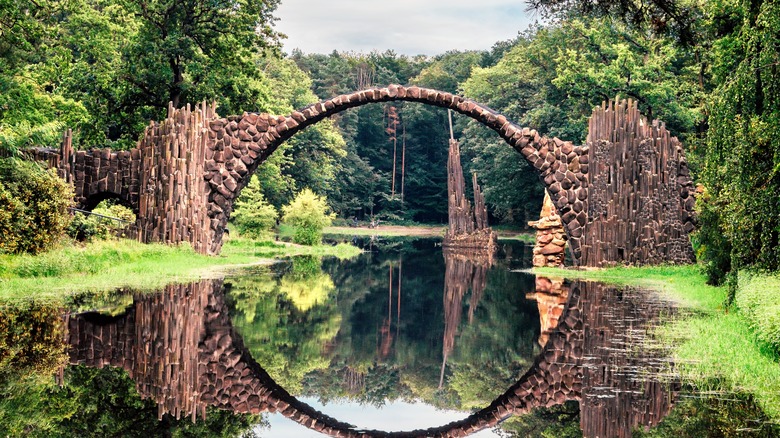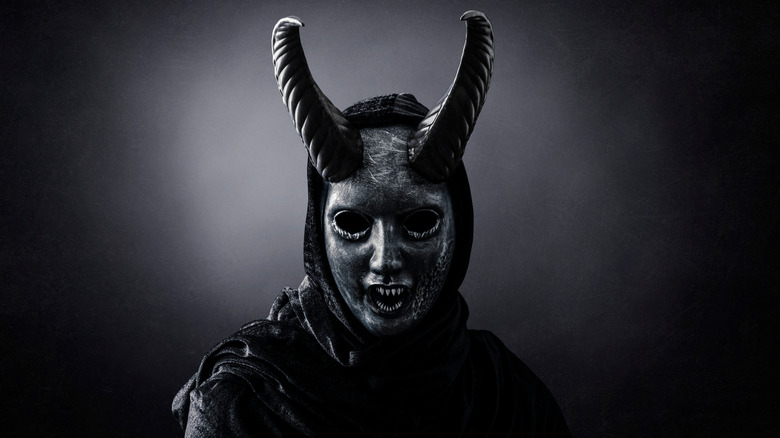Germany's 19th-Century Rakotzbrücke Bridge Is A Work Of Art With A Wicked Name
The Rakotzbrücke bridge in Kromlauer, Germany, appears before you like something out of a foggy reverie summoned from the deep and mysterious psyche of J.R.R. Tolkien. If you were to happen upon it by mere chance while stumbling around Kromlauer Park during the dismal twilight hours, you'd probably think you were staring directly into the Eye of Sauron and start running for your life. Then again, there's a good chance you'd hold your gaze and succumb to the entrancing charm that the astonishing piece of architecture is world famous for.
According to Atlas Obscura, the Rakotzbrücke bridge — which translates to devil's bridge — stretches across a small portion of the park's lake in an elegant curvature that, when reflected by the still waters below, creates the illusion of a perfect, continuous circle. It's commonly understood throughout Europe that these so-called devil bridges are aptly named due to their immaculate construction. Europeans of centuries past postulated that something so perfectly assembled could hardly have been done so by human hands alone. Therefore, the only natural (or supernatural) explanation for the phenomenon was that Satan himself ascended from the depths of hell, gathered some stones, and built the bridge himself before returning to his infernal asylum beneath the soil. Odds are that wasn't the case, but all the same, the Rakotzbrücke is one such bridge that is absolutely spellbinding to behold.
The history of Rakotzbrücke
In 1860, one Friedrich Hermann Rotschke commissioned the bridge's construction, according to The Travel. Basalt stones and various sediments imported from Scandinavian countries were applied in its formation, and for over 150 years, it's maintained its structure and has attracted curious spectators from around the world. Rotschke was reputed to sport an infatuation with gothic architecture, so he was naturally the perfect man for the job.
The Rakotzbrücke bridge is one of those architectural marvels that still puzzles people to this day. While the devil himself likely didn't have a hand in building it, it's still a remarkable feat that defies the capabilities of even the most proficient architect. The bridge was erected almost two centuries ago when modern technological utilities were little more than a figment of one's wildest dreams, so Rotschke had to work with the most rudimentary of construction methods to make it a reality. It's not quite the baffling marvel that is the Egyptian pyramids, but there's no denying the fact that Rakotzbrücke stands out as one of the most unfathomable and wondrous structures ever conceived by mankind (via The Travel).
The legend of Rakotzbrücke and the devil
According to legend, a German woman who lived near the site of the bridge went searching for one of her cows after it escaped from her farm one afternoon. Upon coming to a small section of the lake, she observed it grazing on the opposite bank with no way to reach it. In all of his generosity, the devil appeared and offered her a means to an end should she acquiesce to his wishes. He promised to build a bridge across the water for her cow to cross back over, and all she had to do in return was provide him with a human soul. When your cow's in danger, what choice do you have? She agreed (via The Travel).
Unfortunately, folklore has taught us that there are very few ways to cheat the devil out of his due diligence. The woman attempted to send a dog across the bridge instead of a human to recover the cow, and by means of retaliation, Satan cursed the bridge forever more. Ergo, if you're superstitious, you best not try to cross Rakotzbrücke should you ever pay it a visit. You're also liable to suffer if you ever pass beneath it by boat, as it's reputed to be a gateway into Hell. If all of that isn't enough to deter you, The Travel reports that it's illegal for patrons to interact with Rakotzbrücke so as to preserve it and avoid any possible degradation.


